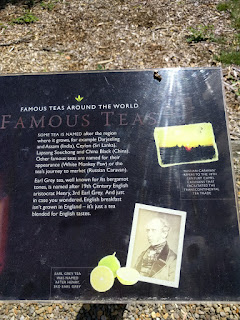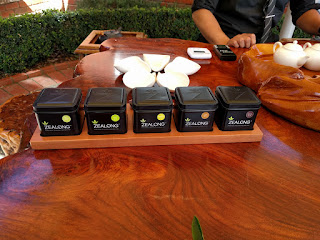While on vacation I made sure to book a visit to the Zealong plantation, I had reviewed them previously and I was going to be on the area.
https://zealong.com/discover-zealong-tea-tour/
When I arrived at The Vista a bit before my tour time there was a nice tasting and show room. Hua made me a sample of the new flavored tea (green tea and roses).
When it was tour time, myself and another couple got to go on a tour with Kevin. The tour started at The Vista (which is half factor, half showroom – sadly you don’t’ actually get to see the factory), and then wander up a walk way with sculptures and statuary. The statues and sculptures actually tell the tale of the history of tea – and the processing of tea.
Kevin went on to explain that there are many creation stories for tea – and the one he featured was the man falling asleep, leaves falling into his boiling water, the water changing color, and deciding to drink it.
Next he explained tea processing – oxidation, withering, rolling, the types of teas. I was quite happy it was a factual and educational bit – I hate when tours give false and/or non detailed information.
Kevin then explained the three leaves and a bud – oolong hinting at dragons (bud being a body and leaves being wings). And then went into specifics about the Zealong plantation.
This lead to us being able to try on the tea pickers hats and jackets and see their gloves. The jacket covers your hands! Quite brilliant to avoid sunburn. The hat really does have great sun coverage. The gloves were interesting – there is a razer blade in them to help with clean cuts of the plucking which is apparently better for the plant. So we donned the hats and jackets, found two leaves and a bud, and plucked! Then had to imagine doing that as fast as you could for hours each day.
The explanation of tea history, processing and plantation facts finished with some videos in a pretty office meeting (event) room with an amazing view and porch.
The tale along the way unfolded as;
When the founder, Vincent Chen, spotted a camellia growing in Australia he thought that perhaps tea could grow in Australia.
He got 1500 cuttings from Taiwan, but due to the tight biosecurity regulations they had to stay in quarantine for 10 months. Only 130 survived. Today they have propagated the 130 into 1.2 million tea trees. It really started out as almost a hobby – could it be done? And now is a thriving business.
The Waikato region is where the plantation is, and overall it has a nice temperature that mimics the Asian climate the tea trees were used to before coming to New Zealand.
Apparently a tea plantation had been tried by another company on the south island but it had failed, likely due to snow and cold.
Everything here is organic, no pesticide, no fertilizer. In fact they are the only ISO 2200 certified tea plantation. This means that they can trace a specific packet of tea back to the date it was picked, how and when it was processed, etc. They just plow and mow over weeds as needed between pickings.
There are three pickings per year (I kept trying to get him to say flushes) approximately Nov, Jan, March. The teas are picked by hands with temporary workers. Some from the area, which are trained for two weeks before they can become tea pickers, and some from Taiwan.
After the teas are picked they are processed into Green, Black or one of the three oolongs. There were some very high tech machines, including rolling machines, involved in this step as seen in the video.
They tried to do a white tea processing but the price was astronomical and the amount that could be produced was so small that they decided against it.
Each picking lasts for about 20 days – depending on weather (heat etc)
At the plantation there is one full time tea master overseeing the processing of tea and 1 part time master.
When needed there are helicopters contracted to keep off the frost by blowing hot air on the plants, they are rented from a company that also offers this service to wineries in the region. At most this is about 3 weeks of risk per year. There are sensors in each plot of tea trees reporting on a variety of information including temperature that are used to best apply this.
Vincent Chen comes back twice a year from Taiwan to check in on the plantation.
After the tour there was a tasting of all the teas at a beautiful wooden table, apparently it was cinnamon wood, done by our lovely tour guide Kevin. There were aroma cups, and we went light to dark as is proper. We chatted about the flavors we were getting from each and generally had a good time and also chatted a bit more about the Zealong plantation. We also got a gift of a sample of tea to take home with each of us.
I was pleased to learn that to work in the office someone had to learn all the elements of tea – it seemed like a great thing to me!
I had opted, as well as the other couple in the morning tour, to finish off with a high tea. This is optional, but either way I fully recommend tea lovers who will be in the area – or who happen to live in the area and were unaware it was there – go ahead and book a tour.
I was sad to find that they did, thanks to customer demand, offer teabags. The tea bags have no plastic, and no glue, but still sad such nice tea to be put through that. Hopefully consumers learn.









































· Permalink
Sounds like a great place to visit.
And ISO 22000? I had to look up for that one.